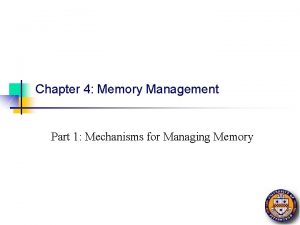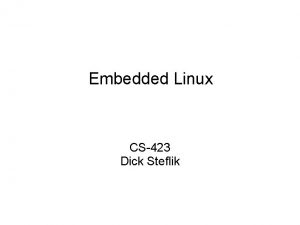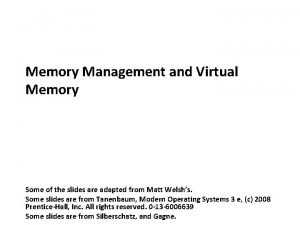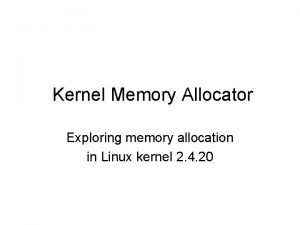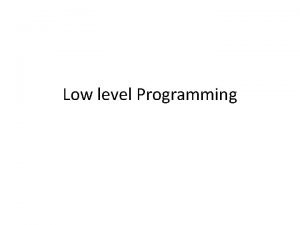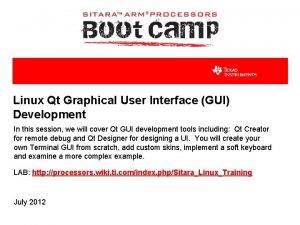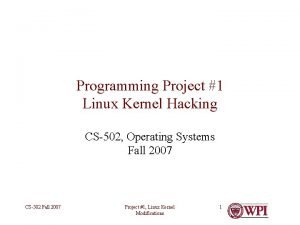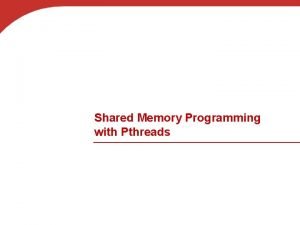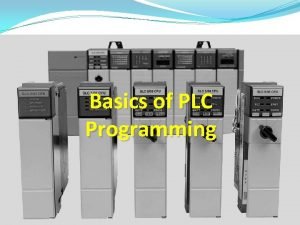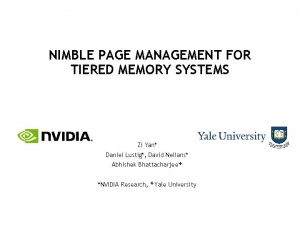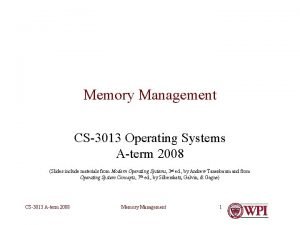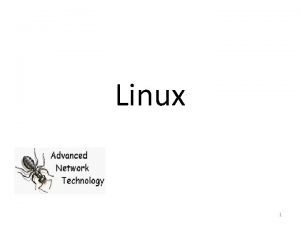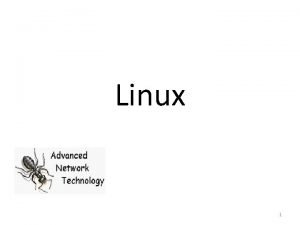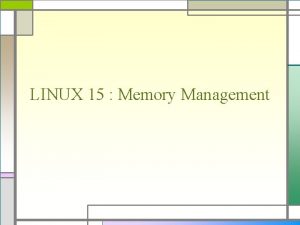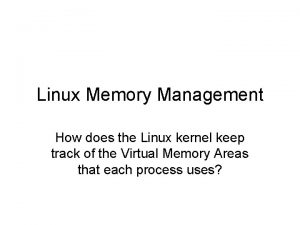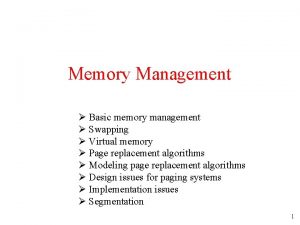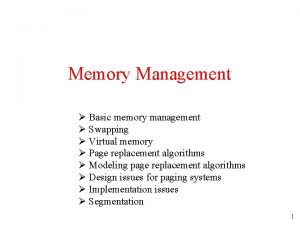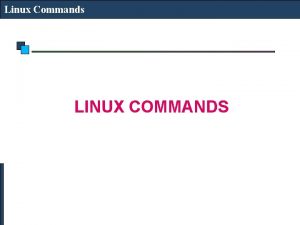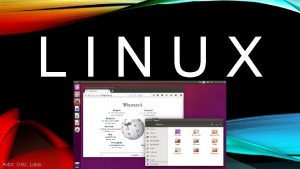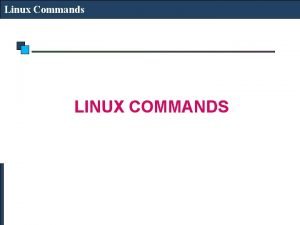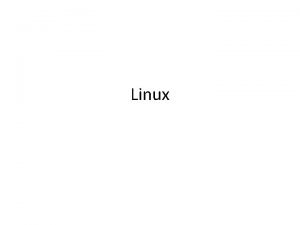UserLevel Memory Management in Linux Programming 1 USERLEVEL
































- Slides: 32

User-Level Memory Management in Linux Programming 1

USER-LEVEL MEMORY MANAGEMENT User-Level Memory Management in Linux Programming § Linux/Unix Address Space § Memory Allocation Library and System Calls § Programming Example 2

USER-LEVEL MEMORY MANAGEMENT Linux/Unix Address Space § Without memory for storing data, it's impossible for a program to get any work done. (Or rather, it's impossible to get any useful work done. ) § Real-world programs can't afford to rely on fixed -size buffers or arrays of data structures. § They have to be able to handle inputs of varying sizes, from small to large. § This in turn leads to the use of dynamically allocated memory—memory allocated at runtime instead of at compile time. 3

USER-LEVEL MEMORY MANAGEMENT Linux/Unix Address Space § A process is a running program. § This means that the operating system has loaded the executable file for the program into memory, has arranged for it to have access to its command-line arguments and environment variables, and has started it running. 4

USER-LEVEL MEMORY MANAGEMENT Linux/Unix Address Space § A process has five conceptually different areas of memory allocated to it: Ø Ø Ø Code Initialized data Zero-initialized data Heap Stack 5

USER-LEVEL MEMORY MANAGEMENT Linux/Unix Address Space § Code Ø Often referred to as the text segment. Ø this is the area in which the executable instructions reside. Ø Linux and Unix arrange things so that multiple running instances of the same program share their code if possible. Ø Only one copy of the instructions for the same program resides in memory at any time. (This is transparent to the running programs. ) Ø The portion of the executable file containing the text segment is the text section. 6

USER-LEVEL MEMORY MANAGEMENT Linux/Unix Address Space § Initialized data Ø Statically allocated and global data that are initialized with nonzero values live in the data segment. Ø Each process running the same program has its own data segment. Ø The portion of the executable file containing the data segment is the data section. 7

USER-LEVEL MEMORY MANAGEMENT Linux/Unix Address Space § Zero-initialized data Ø Global and statically allocated data that are initialized to zero by default are kept in what is colloquially called the BSS area of the process. Ø Each process running the same program has its own BSS area. Ø When running, the BSS data are placed in the data segment. Ø In the executable file, they are stored in the BSS section. 8

USER-LEVEL MEMORY MANAGEMENT Linux/Unix Address Space Ø The format of a Linux/Unix executable is such that only variables that are initialized to a nonzero value occupy space in the executable's disk file. Ø Thus, a large array declared 'static char somebuf[2048]; ', which is automatically zero-filled, does not take up 2 KB worth of disk space. Ø Some compilers have options that let you place zero-initialized data into the data segment. 9

USER-LEVEL MEMORY MANAGEMENT Linux/Unix Address Space § Heap Ø The heap is where dynamic memory (obtained by malloc() and friends) comes from. Ø As memory is allocated on the heap, the process's address space grows. Ø Although it is possible to give memory back to the system and shrink a process's address space, this is almost never done. Ø We distinguish between releasing nolongerneeded dynamic memory and shrinking the address space. 10

USER-LEVEL MEMORY MANAGEMENT Linux/Unix Address Space Ø It is typical for the heap to "grow upward. " Ø This means that successive items that are added to the heap are added at addresses that are numerically greater than previous items. Ø It is also typical for the heap to start immediately after the BSS area of the data segment. 11

USER-LEVEL MEMORY MANAGEMENT Linux/Unix Address Space § Stack Ø The stack segment is where local variables are allocated. Ø Local variables are all variables declared inside the opening left brace of a function body (or other left brace) that aren't defined as static. Ø On most architectures, function parameters are also placed on the stack, as well as "invisible" bookkeeping information generated by the compiler, such as room for a function return value and storage for the return address representing the return from a function to its caller. (Some architectures do all this with registers. ) 12

USER-LEVEL MEMORY MANAGEMENT Linux/Unix Address Space Ø It is the use of a stack for function parameters and return values that makes it convenient to write recursive functions (functions that call themselves). Ø Variables stored on the stack "disappear" when the function containing them returns. Ø The space on the stack is reused for subsequent function calls. Ø On most modern architectures, the stack "grows downward, " meaning that items deeper in the call chain are at numerically lower addresses. 13

USER-LEVEL MEMORY MANAGEMENT Linux/Unix Address Space § When a program is running, the initialized data, BSS, and heap areas are usually placed into a single contiguous area: the data segment. § The stack segment and code segment are separate from the data segment and from each other. 14

USER-LEVEL MEMORY MANAGEMENT Linux/Unix Address Space § Although it's theoretically possible for the stack and heap to grow into each other, the operating system prevents that event. § Any program that tries to make it happen is asking for trouble. § This is particularly true on modern systems, on which process address spaces are large and the gap between the top of the stack and the end of the heap is a big one. § The different memory areas can have different hardware memory protection assigned to them. 15

USER-LEVEL MEMORY MANAGEMENT Linux/Unix Address Space § For example, the text segment might be marked "execute only, " whereas the data and stack segments would have execute permission disabled. § This practice can prevent certain kinds of security attacks. 16

USER-LEVEL MEMORY MANAGEMENT Linux/Unix Address Space § The relationship among the different segments is summarized in below: Program memory Code Initialized data BSS Heap Stack Address space segment Text Executablefile section Text Data Stack BSS Table 3. 1 Executable program segments and their locations 17

USER-LEVEL MEMORY MANAGEMENT Linux/Unix Address Space § Finally, we'll mention that threads represent multiple threads of execution within a single address space. § Typically, each thread has its own stack, and a way to get thread local data, that is, dynamically allocated data for private use by the thread. 18

USER-LEVEL MEMORY MANAGEMENT Memory Allocation § Library Calls § System Calls 19

USER-LEVEL MEMORY MANAGEMENT Library Calls § § malloc() calloc() realloc() free() Ø Dynamic memory is allocated by either the malloc() or calloc() functions. Ø These functions return pointers to the allocated memory. 20

USER-LEVEL MEMORY MANAGEMENT Library Calls Ø Once you have a block of memory of a certain initial size, you can change its size with the realloc() function. Ø Dynamic memory is released with the free() function. 21

USER-LEVEL MEMORY MANAGEMENT Library Calls § void *calloc(size_t nmemb, size_t size) Ø Allocate and zero fill § void *malloc(size_t size) Ø Allocate raw memory § void free(void *ptr) Ø Release memory § void *realloc(void *ptr, size_t size) Ø Change size of existing allocation 22

USER-LEVEL MEMORY MANAGEMENT Library Calls § The allocation functions all return type void *. This is a typeless or generic pointer. § The type size_t is an unsigned integral type that represents amounts of memory. § It is used for dynamic memory allocation. 23

USER-LEVEL MEMORY MANAGEMENT Initially Allocating Memory § void *malloc(size_t size) Ø Memory is allocated initially with malloc(). Ø The value passed in is the total number of bytes requested. Ø The return value is a pointer to the newly allocated memory or NULL if memory could not be allocated. Ø The memory returned by malloc() is not initialized. Ø It can contain any random garbage. Ø You should immediately initialize the memory with valid data or at least with zeros. 24

USER-LEVEL MEMORY MANAGEMENT Releasing Memory § void free(void *ptr) Ø When you're done using the memory, you "give it back" by using the free() function. Ø The single argument is a pointer previously obtained from one of the other allocation routines. Ø It is safe (although useless) to pass a null pointer to free(). 25

USER-LEVEL MEMORY MANAGEMENT Changing Size § void *realloc(void *ptr, size_t size) Ø It is possible to change the size of a dynamically allocated memory area. Ø Although it's possible to shrink a block of memory, more typically, the block is grown. Ø Changing the size is handled with realloc(). 26

USER-LEVEL MEMORY MANAGEMENT Allocating and Zero-filling § void *calloc(size_t nmemb, size_t size) Ø The calloc() function is a straightforward wrapper around malloc(). Ø Its primary advantage is that it zeros the dynamically allocated memory. Ø It also performs the size calculation for you by taking as parameters the number of items and the size of each. 27

USER-LEVEL MEMORY MANAGEMENT System Calls § brk() § sbrk() 28

USER-LEVEL MEMORY MANAGEMENT System Calls § int brk(void *end_data_segment) Ø The brk() system call actually changes the process's address space. Ø The address is a pointer representing the end of the data segment. Ø Its argument is an absolute logical address representing the new end of the address space. Ø It returns 0 on success or -1 on failure. 29

USER-LEVEL MEMORY MANAGEMENT System Calls § void *sbrk(ptrdiff_t increment) Ø The sbrk() function is easier to use. Ø Its argument is the increment in bytes by which to change the address space. Ø By calling it with an increment of 0, you can determine where the address space currently ends. 30

USER-LEVEL MEMORY MANAGEMENT System Calls § Practically speaking, you would not use brk() directly. § Instead, you would use sbrk() exclusively to grow (or even shrink) the address space. 31

USER-LEVEL MEMORY MANAGEMENT Program example § The following program summarizes everything about address space. § Note that you should not use alloca() or brk() or sbrk() in practice. § Example 8. 1: Memory Address 32
 Linux memory management
Linux memory management Linux security modules
Linux security modules Uclinux
Uclinux Message passing os
Message passing os Virtual memory linux
Virtual memory linux Linux memory allocator
Linux memory allocator Linux kernel map
Linux kernel map Low level programming language
Low level programming language Qt framework
Qt framework Linux kernel hacking
Linux kernel hacking Episodic memory
Episodic memory Implicit memory vs explicit memory
Implicit memory vs explicit memory Long term memory vs short term memory
Long term memory vs short term memory Internal memory and external memory
Internal memory and external memory Primary memory and secondary memory
Primary memory and secondary memory Logical and physical address in os
Logical and physical address in os Which memory is the actual working memory?
Which memory is the actual working memory? Page fault
Page fault Virtual memory in memory hierarchy consists of
Virtual memory in memory hierarchy consists of Eidetic memory vs iconic memory
Eidetic memory vs iconic memory Shared vs distributed memory
Shared vs distributed memory Pthread_yield example
Pthread_yield example Explain plc memory organization
Explain plc memory organization Perbedaan linear programming dan integer programming
Perbedaan linear programming dan integer programming Greedy vs dynamic programming
Greedy vs dynamic programming Windows 10 system programming, part 1
Windows 10 system programming, part 1 Integer programming vs linear programming
Integer programming vs linear programming Definisi linear
Definisi linear Salt linux management
Salt linux management Belady's anomaly example
Belady's anomaly example Virtual memory in os
Virtual memory in os Tiered memory
Tiered memory Memory management
Memory management
